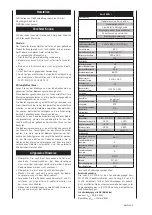
12 english
Not part of scope of delivery:
1 Flat wrench
SW 13
Due to technical reasons, your packed planing machine is not
fully assembled.
The planing machine shouldn‘t be lifted onto the work ta-
ble!
Setup and adjustment, Fig. 4
The machine stands on 4 adjustable rubber cushions.
Balance the unevenness of the floor. Loosen the lower
hexagon nut using the key and turn the rubber cushions
correspondingly in and out.
Tighten the hexagon nut again. (secure the hexagon nut)
Attention!
Be sure to align the machine by using a level.
If the rubber cushions are displaced, the machine can be
bolted into the boreholes in the floor.
For utilization with a base frame, dismantle the rubber
cushions and screw on the frame.
Planer fence, Fig. 5.1
Attach the planer fence to the machine.
Set the position to 90° with the help of a stop angle.
Tighten the release handle (1)
The planer fence is continuously variably pivoting from 90°
– 45°, where the pivoting segment must be loosened.
Check each model item with a protractor for dimension
accuracy after every angle adjustment.
Planer fence setup, Fig. 5.2
Check the 90°/45° angle and set the cylinder head screws
M4x8.
1 = Set screw 90° angle
2 = Set screw 45° angle
Attention!
The planer fence must always remain firmly fixed.
Fig. 5.3
The clamping of the planer fence results from the exocen-
tric lever. (1)
The planer fence is 260 mm adjustable over the planer.
Attention!
The planer fence must always remain firmly fixed.
Planer shaft guard, Fig. 5.4
Screw on the planer shaft guard onto a hinged work table.
The planer shaft guard can be deviated without a tool by
pulling the exocentric lever upwards,
swaying the shaft guard, pulling the exocentric lever back
down.
Fig. 7 + 8
Attention: Never work with planer fences without the shaft
guard.
m
Operating Instructions
Preparing and setting up the machine
Changes, setup, measuring and cleaning work on the
•
machine should only be done with the motor turned off.
Disconnect the power plug and wait for the shutdown
of the rotating tools.
After repairs and servicing, all protective and safety
•
equipment must be immediately assembled.
Immediately exchange defective planer knives (rifts or
•
such). Monitor the knife change!
Check the effectiveness of the anti-kickback attach-
•
ment before each operation. The gripper taper must
have a sharp edge.
After repairs and servicing, all protective and safety
•
warnings must be immediately mounted onto the ma-
chine.
Thickness and work
Maximal planer shaft speed 6500 1/min
•
The planer shaft has been manufactured in accordance
•
with DIN EN 847-1.
Begin the working operation only when the full speed
•
is reached.
Keep the operator station free of shavings and wood
•
waste.
Employ the extraction unit for extraction of shavings
•
and wood dust. The velocity of flow of the extraction
support must amount to min. 20 m/s.
Work only with sharpened planer knives. Dull planer
•
knives increase the risk of relapse.
When processing long work pieces (longer than the
•
feeding table) roll racks (optional equipment) should
be employed.
Work: When dressing a work piece up to 75 mm thick,
•
the planer shaft guard must cover the work piece and
the planer shaft from above. If the work piece width
is more than 75 mm, set the protective rails of the
shaft guard to the width of the work piece. Make sure
to put closed hands, with the thumb adjacent on the
work piece.
Joining: The work piece is set against the work stopper.
•
Set the rails of the shaft guard to the width of the work
piece and leave on the table.
Dressing and joining of small cross sections (strips):
•
When dressing the work piece, same as for work pieces
up to 75 mm thick, it should be fed with spread out
hands. When joining, push the work piece with both
hands, with the fists closed, against the help stopper
(optional equipment) and feed it through. The guard
device is positioned near by and rests on the work
piece.
Dressing and joining of small work pieces: When dress-
•
ing, push the work piece with spread out hands to the
work table and feed through with the pusher, using the
right hand. The left hand slides over the guard device,
as long as the work piece is on the table the weight of
the left hand will shift onto the receiving table. When
joining, push the work piece with the left hand, with
the fist closed, against the help stopper and the table,
then feed through with the pusher.
Chamfering or beveling: The work piece should be
•
leaned against the work stopper. Set the protective
rails of the shaft guard to the the width of the work
piece and leave the piece on the table. Push the work
piece with the left hand, with the fist closed, against
the stopper and the receiving table and feed it through
with the right hand closed.
Beginning
Before starting, observe the safety warnings. All guard and
help devices must be installed.
Changes, setup, measuring and cleaning work on the ma-
chine should only be done with the motor turned off.
Summary of Contents for hms 2600ci
Page 75: ...international 77 INTERNATIONAL...
Page 76: ...78 international...
Page 77: ...international 79...
Page 78: ...80 international...
Page 79: ...international 81...
Page 80: ...82 international...
Page 81: ...international 83...
Page 82: ...84 international...
Page 83: ...international 85 71370045 71370046 06 06 2008...
Page 85: ...international 87...
Page 86: ...88 international...
Page 87: ...international 89...
Page 88: ...90 international...











































